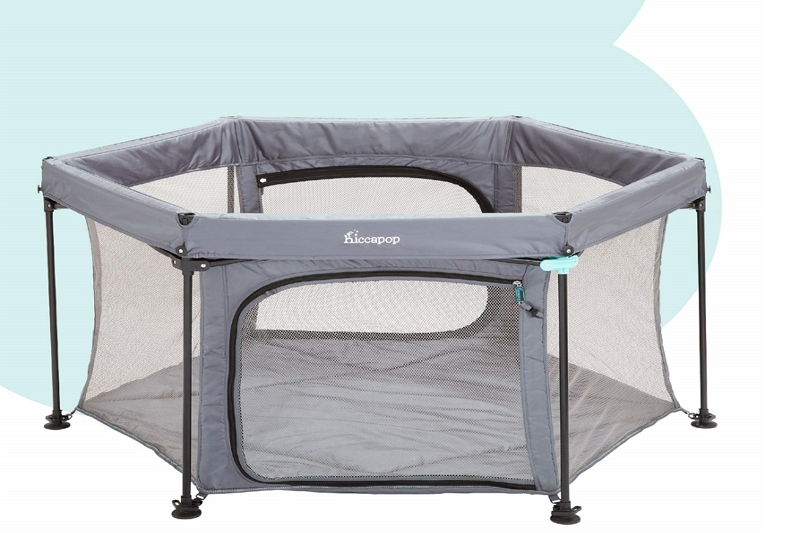At what age is a child ready for a playpen? The American Academy of Pediatrics recommends using a playpen for an infant when they are between six to eight months old.
As your child grows, you can start removing the baby from the pen and then eventually remove their use completely. This will help with mental development as well as physical growth.

If you notice any issues concerning possible developmental delays in young children, it is best to speak to your doctor or paediatrician immediately since there may be something else going on that requires medical attention instead of just behavior problems caused by not having enough space or freedom within the confines of a small area like a playpen.
It would also be beneficial if parents did some research online about how long babies should stay in this type of confinement so that they know exactly what age they should stop using the pen for their child’s safety.
How do I transition my baby to his room?
* Once your baby has outgrown the bassinet, you should transition him to his crib. *You can place a mattress on top of the existing one and slowly lower it as he gets older.
* If you don’t want this option, then simply buy an additional mattress. You will need at least two mattresses for this process: one in the nursery and another elsewhere (in case your child is napping somewhere else). The other option would be to use a pack ‘n play instead of buying multiple mattresses.
This also works great because it still simulates being in mommy and daddy’s room while allowing them their privacy during nap time or overnight sleeping!
* It may take anywhere from one day to several weeks before your child is comfortable with his new room.
* It’s important to keep the nursery consistent and inviting during this transition, so continue putting him down for naps there until he adjusts. You can also begin sleeping in another bedroom if you feel that will help speed up the process.
* Continue providing a nightlight or some other source of light as well since babies tend to be comforted by their surroundings at nighttime too.”
Can you use a crib as a co-sleeper?
We recommend not using a crib as a co-sleeper. There is no way to attach the mattress in your baby’s classic crib directly to the bed for safety reasons, and it can be very dangerous if you do use one of these types of products.
Your little one could roll off easily from this type of sleeping arrangement, which could lead to serious injuries or even death! So please don’t put yourself at risk when trying to make nighttime easier on your household.
Instead, try an alternative like our Snuggle Me Original Co-Sleeper with Firm Mattress that attaches securely onto any size adult bed so parents get extra peace of mind while their infant sleeps nearby safely all night long without worrying about rolling over them during sleep.
How do you secure a crib to a bed?
A crib and a bed must be secured together to prevent the baby from rolling out of the crib. Cribs should never be placed near windows or other openings that can allow children access to hazards such as balconies, pools, staircases and garages.
Make sure all sharp corners are padded using soft corner bumpers or foam corner covers for safety purposes. Move anything you could trip over like toys away from your child’s reach while they sleep in their crib.
This will help ensure [no] accidents [occur]. It is important to make sure there are no items under beds between mattress supports where a baby may become stuck if crawling into tight spaces underneath the bed frame bottom edge.
You also want to remove any tripping hazards like cables, electrical cords and wires that your child could crawl over while sleeping in their crib. An infant can suffocate on these items if they roll into them when entering or exiting the crib.
Make sure all of these hazards are out of reach for a baby to prevent any accidents from occurring with an infant while sleeping in their bed.
Are co-sleepers portable?
Yes, co-sleepers are portable. They can be used everywhere you go to keep your baby safe and close to you at nighttime. Many parents use their co-sleeper as a bassinet when travelling with babies, moving it from room to room in the home or taking them outside for picnics.
The one caveat is that some models require an adult assembly upon purchase which does take time but may also provide added safety benefits because of how sturdy they are made.
Why are bedside sleepers not safe?
Some bedside sleepers have been reported to contain toxic chemicals like formaldehyde.
The American National Standards Institute (ANSI) requires all manufacturers of furniture that contains or is made with pressed wood panels to list the content of these materials by name, including any added chemical preservatives and their levels in parts per million.
However, because there are no standards for labelling products as “bedside sleeper-safe” this information can be difficult to find when shopping at local retailers.
Once you get your hands on one it should come with a warning label which will indicate if the product has an open flame ignition source, flammability rating or meets fire safety requirements issued by 16 CFR Part 1632 Standard for Bed Mattresses and Pads.
